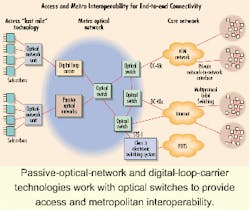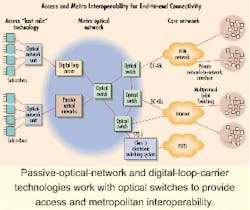PON, DLC technologies overcome infrastructure limits
High-speed service demands strain incumbent carrier access networks; fiber-based technologies promise relief.
Pam Dodge
Astral Point Communications Inc.
Today's telecommunications customers may be clamoring for new high-speed services, but carriers' existing local-loop/access infrastructures largely remain inadequate to meet such demands. Incumbent carriers have been slow to address the many challenges involved in updating their infrastructures. But as new carriers and competitive local-exchange carriers (CLECs) enter the market, incumbents are starting to employ service-enabling technologies such as passive optical networks (PONs) or digital loop carriers (DLCs) into the local loop.
The move into the local-loop/ access market by emerging carriers and CLECs represents the first real competitive challenge to incumbent service providers. These providers have long been dominant in, and highly protective of, this market space. That's not surprising, considering that the local-loop/ access market represents 40% of their revenues.
Emerging carriers and CLECs are beginning to gain strength in this market, because these new players have the advantage of building infrastructures that are optimized for service delivery from the ground up. The new infrastructures can bypass existing access networks by using coaxial distribution networks and radio access technology. This approach allows emerging carriers to quickly offer DSL, video, and other high-speed services.
In contrast, existing local-loop/access infrastructures are antiquated, costly to operate, and inadequate for deploying new high-speed services. On average, these networks consume about 70% of the total cost of operations. Moreover, it can take as much as 14 days to provision services, 11 days for building out local-loop connections at each end (local-loop conditioning, crossconnects, high-bit-rate DSLs), and three days for setting up interoffice connections. To provision next-generation services, many existing access networks will require extensive grooming and design work.
Today, PON technology and a new fiber-based version of DLC are beginning to level the competitive playing field. These technologies will allow incumbent carriers to overcome the limitations of existing infrastructures by helping to streamline service provisioning from 14 days to as little as three days. These advanced technology devices save time by incorporating fiber optics with SONET speeds.
DLC technology provides equipment for bundling individual phone lines into a single multiplexed signal. This signal provides the advantage of eliminating the cost of using copper for local traffic between telephone company central offices and businesses or other outlying areas.
Fiber-based DLC technology can handle the higher bandwidth required for DSL and other high-speed services. Thus, it is well suited for Internet service providers that want to manage Websites from a small-office/home-office environment. The technology combines up to 24 analog voice calls into a single signal for transmission over single copper T1 or E1 lines on optical-fiber cable or wireless connections. With fiber-based DLC, optical-line-termination (OLT) units are connected to optical-network units (ONUs).PON technology lowers optical deployment and maintenance costs and also creates cleaner signals by limiting the required amount of lasers, regenerators, and amplifiers. PONs consist of OLT units connected to ONUs through the point-to-multipoint connection. The technology's point-to-multipoint connection enables carriers to support numerous end locations with a single fiber.
The common denominator for both PONs and DLC is fiber. It enables both technologies to support all types of services and greater numbers of subscriber lines than ever before. For instance, by installing optical-fiber-based PONs or DLC as far as the ONUs, carriers can transmit services over the short remaining sections of distribution networks at rates of up to 51 Mbits/sec. This approach cuts infrastructure costs and enables service providers to quickly roll out new services and integrate those services into the network.
Fiber-optic technologies provide additional advantages for PON and DLC systems. Optical fiber enables carriers to give business customers prodigious amounts of bandwidth, which can result in thousands of dollars in service revenues per month. Fiber optics also gives PON and DLC systems the capability to perform automatic testing functions and self-configuration, enabling networks to inexpensively adapt to changes in operations, administration, and maintenance processes.
With PON technology, signals are routed over the local link. Along the way, optical splitters route signals through the network. Optical receivers are placed at intermediate points in the network. The subscriber terminals are tuned for specific wavelengths of light to direct signals intended for groups of subscribers. At the final destination, each subscriber-business or residence-can detect its own specified signal. PONs can deliver as much as 622 Mbits/sec of downstream traffic and 155 Mbits/sec of upstream traffic. This bandwidth can be changed dynamically depending on user needs.
By using PON technology, incumbent carriers can prepare their entire optical plant for customer service but activate only the portion of the plant that is actually needed for service at any given time. By enabling carriers to activate connections as needed, PONs eliminate the traditional geographic restrictions that early equipment placement can cause. By using this method, incumbent service providers can reduce their initial cash outlay and add new customers quickly and easily.
In addition, PONs can provide large amounts of bandwidth, which service providers can flexibly allocate to different users, depending on the specific requirements of those users. This high-bandwidth capacity and flexibility combined with point-to-multipoint topology improves transmission reliability and makes the architecture suitable for both interactive and distributed services.
The passive nature of PON technology provides additional cost benefits. For instance, in the event of a power outage, carriers can easily redirect PON systems without the use of electricity. That eliminates reliance on remote optical amplifiers, which must be housed in costly controlled environmental vaults.
Although PONs have many advantages, the technology is still relatively new. Because of that, there are some drawbacks. These drawbacks, while significant, should disappear as the technology matures. For example, currently there are no reference standards for interoperability between PON technologies from different vendors and installation costs remain expensive.
Despite the numerous advantages, there are several problems involved in economically bringing fiber to businesses of all sizes. So far, the technologies required to turn fiber into services has been highly specialized and cost-prohibitive. These technologies involve linking fiber strands to expensive SONET-based nodes. The fiber must be terminated with optical/electrical devices that couple the fiber to the customer and the other elements in the service-provider network. Supporting a single customer in this way can require an initial deployment of a half-dozen nodes and cost millions of dollars.
Clearly, DLCs and PONs hold a great deal of promise for overcoming the limitations of today's existing local-loop/ access infrastructures. But simply deploying these technologies in access networks will not be sufficient to tap their full potential.
Operational costs in local loops will not go down until these infrastructures can be connected to metropolitan networks. This interconnection will enable end-to-end transport, lower operational costs, reduce potential points of failure, and allow faster service provisioning (see Figure).
There are two ways to achieve the necessary connections. The first is for access and metro DWDM vendors in the optical space to form partnerships to develop solutions whereby systems will interoperate end-to-end. This approach will allow for provisioning across the entire network. The second way to connect these networks and enable end-to-end provisioning is for the individual vendors in the access and metro space to provide standard interfaces such as CORBA (common object request broker architecture) to service providers' operation support systems. With standard interfaces, service providers would not be restricted in choosing which vendors to partner with to build their networks.
In either case, the desired result -integration between the local-loop/access network and metro network-is achieved. Startup costs in the last mile will lower by giving service providers a quicker return on investment in terms of the number of subscribers they can provision faster and more efficiently.
Pam Dodge is director of product marketing for Astral Point Communications Inc. (Chelmsford, MA). She can be reached at (978) 367-6260 or [email protected].

